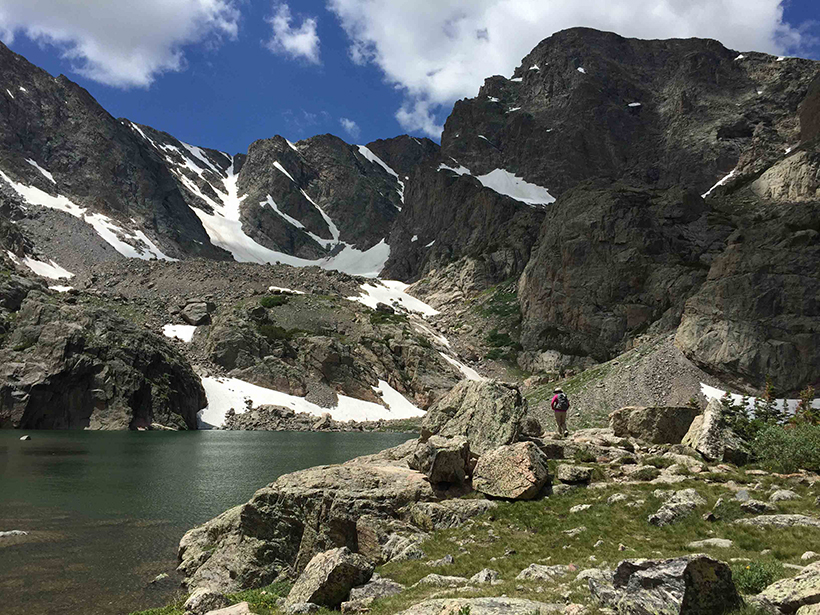Alpine zones in many mountainous regions are warming faster than the global average. Recently observed changes in mountain lakes, including warming and increased algal growth, make it more urgent for scientists to understand the fundamental processes and properties of these lakes and to anticipate their future responses to global change.
Alpine and subalpine mountain lakes of the Northern Hemisphere are important witnesses to global change because of their rapid response to climate and atmospheric deposition and their relatively undisturbed catchments compared with lakes at lower elevations. These water bodies naturally contain low levels of organic matter and nutrients, making them ideal sites to better understand the effects of climate warming on lakes in general.
Attendees considered whether mountainous regions are experiencing increases in extreme events.
However, the combined changes in the amount and type of precipitation, along with atmospheric deposition of nitrogen, phosphorus, and contaminants, complicate our efforts to understand the immediate and long-term consequences of global climate change on these sensitive water bodies.
To discuss these changes, researchers and resource managers from North America and Europe held a workshop earlier this year. Attendees discussed how extreme climate events and changes in precipitation influence biogeochemical cycling, especially the cycling of key nutrients essential for life. They considered whether mountainous regions are experiencing increases in extreme events. If so, how do local watershed characteristics moderate climate-driven influences on lakes?
A warmer climate could increase the probability of rain-on-snow events, exacerbate glacier retreat, and induce permafrost thaw, all of which alter the timing and quantity of runoff and quality of nutrient delivery to lakes. Climate change may lead to shorter winters and warmer summers. So workshop attendees wondered, What will be the ramifications on lake dynamics, particularly algal productivity and photosynthesis? Changing climatic regimes may interact with atmospheric pollution and nonnative species introductions to cause profound biological changes in mountain lakes. These stressors could have implications for downstream water quality and energy movement through food webs.
Workshop participants developed a conceptual framework unique to mountain ecosystems. This framework takes advantage of elevation gradients, long-term measurements, and experiments to develop a comprehensive understanding of ecosystem change.
Efforts are already underway to evaluate factors that determine the sensitivity of mountain lakes to species turnover.
The group developed a template for a growing and comprehensive database, which will address many other research questions raised at the workshop, such as whether the species assemblages and food webs of mountain lakes are resilient to climate perturbations due to the highly variable environment in which they reside. Additionally, are winter conditions changing in mountain ecosystems? Efforts are already underway to evaluate factors that determine the sensitivity of mountain lakes to species turnover, using data from this growing database of dozens of lakes in the Northern Hemisphere. Additionally, attendees reported that several national parks in the western United States will coordinate targeted sampling efforts to better understand interactive effects between temperature and nutrients in regulating algal growth.
Although the workshop organizers and participants were primarily limnologists, we welcome the participation of other disciplines, including hydrology, atmospheric science, and climatology. We aim to continue building a comprehensive network of data that increases the probability of understanding lake processes and anticipating system changes to mountain lakes worldwide.
Readers who would like to help document the extent of algal growth in mountain lakes can download WATR2016, a citizen science app for iPhones available from iTunes. Register for the program through the app, and follow the instructions for taking and uploading pictures of mountain lake algal growth. All data will be compiled in the Alpine Algal Bloom Monitoring database on CitSci.org.
—Isabella Oleksy (email: [email protected]), Natural Resource Ecology Laboratory, Colorado State University, Fort Collins; and Joshua Culpepper, Division of Hydrologic Sciences, Desert Research Institute, Reno
Citation:
Oleksy, I.,Culpepper, J. (2017), Understanding mountain lakes in a changing world, Eos, 98, https://doi.org/10.1029/2017EO082281. Published on 20 September 2017.
Text © 2017. The authors. CC BY-NC-ND 3.0
Except where otherwise noted, images are subject to copyright. Any reuse without express permission from the copyright owner is prohibited.

